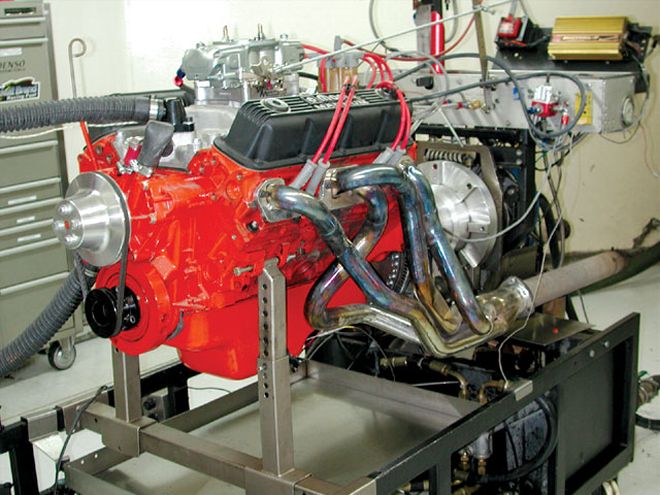

When Chrysler introduced the 5.9-liter Magnum engine in 1993, it was a big step forward in terms of production engine output. The 360ci powerplant was originally introduced in 1971 as a low-compression engine with only a two-barrel carburetor available. There were a few performance variants of the 360 in the early and mid-'70s, however, these were all of the low-compression variety, working under the further disadvantage of add-on smog control equipment. In the early years, the 360 garnered the reputation of being a low-performance smog-motor, and it took decades for this impression to lose its hold. Eventually, the 360 earned its acceptance from Mopar enthusiasts, and has grown to become one of the favored power plants for performance use, especially when the objective is high output on a workingman's budget.
From its humble beginnings low on the performance totem pole, the 360 emerged in 1979 as the top-dog performance offering from Chrysler. While it was as good as could be had in that era, the output through the '80s and early '90s was something less than inspiring. Looking to gain an edge on the offerings of competitive makes, Chrysler significantly revised the basic old warhorse with the Magnum version of the 360, now labeled the 5.9. Changes were made to improve the engine in output, reliability, and sealing against oil leakage. Chrysler succeeded on all three counts, with revised cylinder heads, modern MPI fuel injection, and improved assembly gaskets and seals. The 5.9 Magnum continued as the top Mopar powerplant, lending its muscle to Mopar's popular late-model truck, van, and SUV offerings, until the introduction of the new 5.7 Hemi.
From a low-buck performance standpoint, what makes the 360 a winner is the ready and common availability of these power plants. The older LA-series 360 was produced in abundance, and enthusiasts soon found they responded to bolt-on modifications with ample power output. A likely performance engine combo could be had from any boneyard, ready to swap in place its smaller small-block or six-cylinder brethren. With the right bolt-on performance goodies, even an otherwise stock 360 would hold its own. However, it has been better than two decades since the last of the 360 LA-series power plants have been fitted to production passenger cars, and nearly a decade and a half since the last of these traditional small-blocks have been installed in trucks. The days of finding a serviceable, used LA-series 360 ready to swap are drawing to a close. Sure, these engines can be economically rebuilt, but even good cores are getting harder to find these days.
The later model Magnum engines open the door to a number of possibilities. Good used 5.9 Magnum engines are available from late-model used parts sources, ripe for whatever performance plans you might have in mind. Some of the design improvements incorporated in the late small-block design are an asset on the street, even in a traditional musclecar installation. The factory cylinder heads offer reasonably good airflow, the revised seals and gaskets make nasty oil seepage far less likely, and if high tech is your interest, the possibilities are wide open for a fuel-injected application. That's all fine and dandy, but what about power? In recent years the aftermarket has brought out items that help put power in the Magnums punch, most notably Magnum performance parts from Edelbrock, Competition Cams, and Mopar Performance.
Mopar Performance has the longest running history for building Magnum muscle, with the Magnum 5.9 or 360 the basis of their small-block high-performance crate engines and short-blocks for years. Mopar's crate engines were offered in 300hp and 380hp versions, both based on the production Magnum 5.9. The hotter of these two engines featured a long duration camshaft, single-plane Mopar Performance intake, and higher compression pistons. The 300hp version was essentially the same engine as a typical Durango or Ram truck, with the intake manifold swapped over to take a traditional four-barrel square-bore carb instead of the production fuel injection. We were interested in exploring the performance potential of one of these basic Magnum motors, with the notion that the results would be representative of an effort starting with any serviceable or remanned production 5.9 Magnum, as well as Mopar's milder crate.
What was the game plan? We wanted to keep the combination street-friendly, and limit the mods to direct bolt-ons, keeping the short-block dead stock. This negated the possibility of custom machining, radical race parts, or one-off porting. We aimed our efforts towards the type of engine that would be in keeping with a typical build-up for a traditional performance application. With that in mind, the plan was to retain simple carbureted induction, and let the modifications revolve around the familiar enhancements of the induction system, headers, camshaft, and cylinder heads. What we ended up with is a 430hp powerhouse, built up around a factory Magnum 360 bottom end. The up-shot is the modifications involved nothing but straightforward bolt-ons, with no custom tricks. Want to know more? Read on for the full scoop.